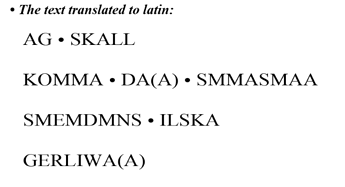Well, a couple of days ago I messaged Marco Bianchi, on Uppsala Runic Forum. He is professor at Department of Scandinavian Languages Uppsala university Sweden, to ask if he had any idea for the “Smmasmaa” sequence in our puzzling runestone. This is what I got back.
"Dear Gysbert,
This is indeed an intriguing and very interesting inscription. I discussed it with my colleague Maja Bäckvall who has done work as a language and rune consultant in the gaming industry, but was not aware of the rune stone in this particular game. Unfortunately we were not able to find a solution to the sequence smmasmaa. I will try to summarise our discussion here.
(1) There are a few errors in your transcription. Swedish “å” is written with two ᚨ-runes in “daa” (‘då’) and “aat” (‘åt’). In both cases, the second ᚨ is much less distinctly painted. I think this observation is important in the interpretation of “smasmaa”. There, also, the second ᚨ is a bit less distinctive which results in a transcription smmasmå. ᛚᛁᚹ is spelled with the rune ᚹ (not ᚡ as in your transcription).
(2) The above suggested reading smmasmå allows for interpretations including, e.g., the Swedish words “må” (‘may’) or “små” (plural of “liten” ‘small’).
(3) The interpretation “då sem Asmaa smedens ilska” is problematic for several reasons. First, “sem” is not a Swedish word. It is, however, an Old Icelandic word corresponding to Swedish “som”. For graphical reasons, a carving error ᛋᛗᛗ for ᛋᛟᛗ is much harder to accept than ᛋᛗᛗ for ᛋᛖᛗ. Second, the formulation “då som” is hardly acceptable (and most definitely not idiomatic) in Swedish. But it could of course be a way to mimic Old Icelandic. Third, the whole expression “då som Asmaa smedens ilska ger liv” is quite unorthodox, to say the least.
(4) As I mentioned above the words “må” or “små” could be hidden in the sequence ᛋᛗᚨᚨ but none of them really matches the rest of the sentence. “må” is impossible because there is already a finite verb (“ger”) later in the sentence; “små” is impossible because it is a plural form but the following noun (“smeden”) is inflected in singular.
(5) The not so very exciting consensus Maja and I reached is to just skip the sequence smmasmå and see it as some sort of decoration. Without it, the sentence is written in perfectly idiomatic Swedish: “den dag skall komma då smedens ilska ger liv åt metallen” (‘The day will come when the blackmith’s anger gives life to the metal’). We admit that this is not very satisfying; such decorative runes would have been easier to explain at the end of the inscription. Maybe, it is just a copy error by the graphics person: they intended to write ᛋᛗᛖ but happened to mix up the ᛗ- and ᛖ-runes and wrote ᛋᛗᛗ instead.
(6) I found the forum entry about the rune stone after my discussion with Maja and read it with great interest. I am aware that some of our thoughts have already been expressed by the players of the game. I would just like to make clear that we were not influenced by the forum thread when we discussed the inscriptions  .
.
One last question: is the blacksmith Asmaa (Asmå) a character in the game? Or put another way: is there any reason not to drop Asmaa from the interpretation?
Best wishes, Marco Bianchi, Uppsala Runic Forum"
 (Even though the grammar is quite close to swedish)
(Even though the grammar is quite close to swedish)


 .
.






